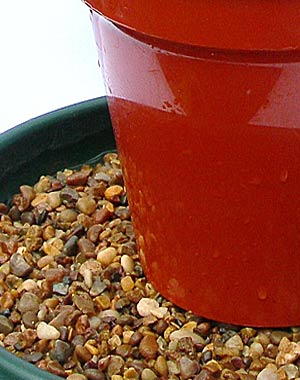
When visiting tropical countries where the majority of orchids grow, a striking climatic feature is the humidity which may be uncomfortable to us but is relished by orchids. In cultivation high humidity levels should be strived for but are not as crucial as sometimes suggested. In the greenhouse damping down with a hose pipe is a simple way of achieving elevated moisture levels.
In the home particularly if centrally heated the humidity can be very low. To overcome this sit your orchid pot on a tray of moist but not wet gravel.
Orchid genera such as Masdevallia and Odontoglossum should always be kept in a humid atmosphere. A symptom of a dry atmosphere sometimes seen on an orchid is an accordion-like crinkling of leaves.
Spraying water on leaves as a means of increasing humidity is only effective for short periods. Spraying water on leaves is an invitation for fungal and bacterial disease typically causing unsightly leaf spotting and basal bulb rot so it should only be conducted on warm summer mornings and it is not recommended during the winter.
Closely linked to humidity is air circulation. Ventilation is extremely important to growing healthy orchids. It removes the stale air containing microbial spores and replenishes carbon dioxide needed for photosynthesis.
In the greenhouse and the home, ventilation should be always kept in mind. Even on mild winter days windows should be kept open at every opportunity and always done so during the summer except during cold spells.
Did you know...
Some victorian botanists were undecided whether epiphytic orchids were actually plants because they seemed to live only off air humidity!
